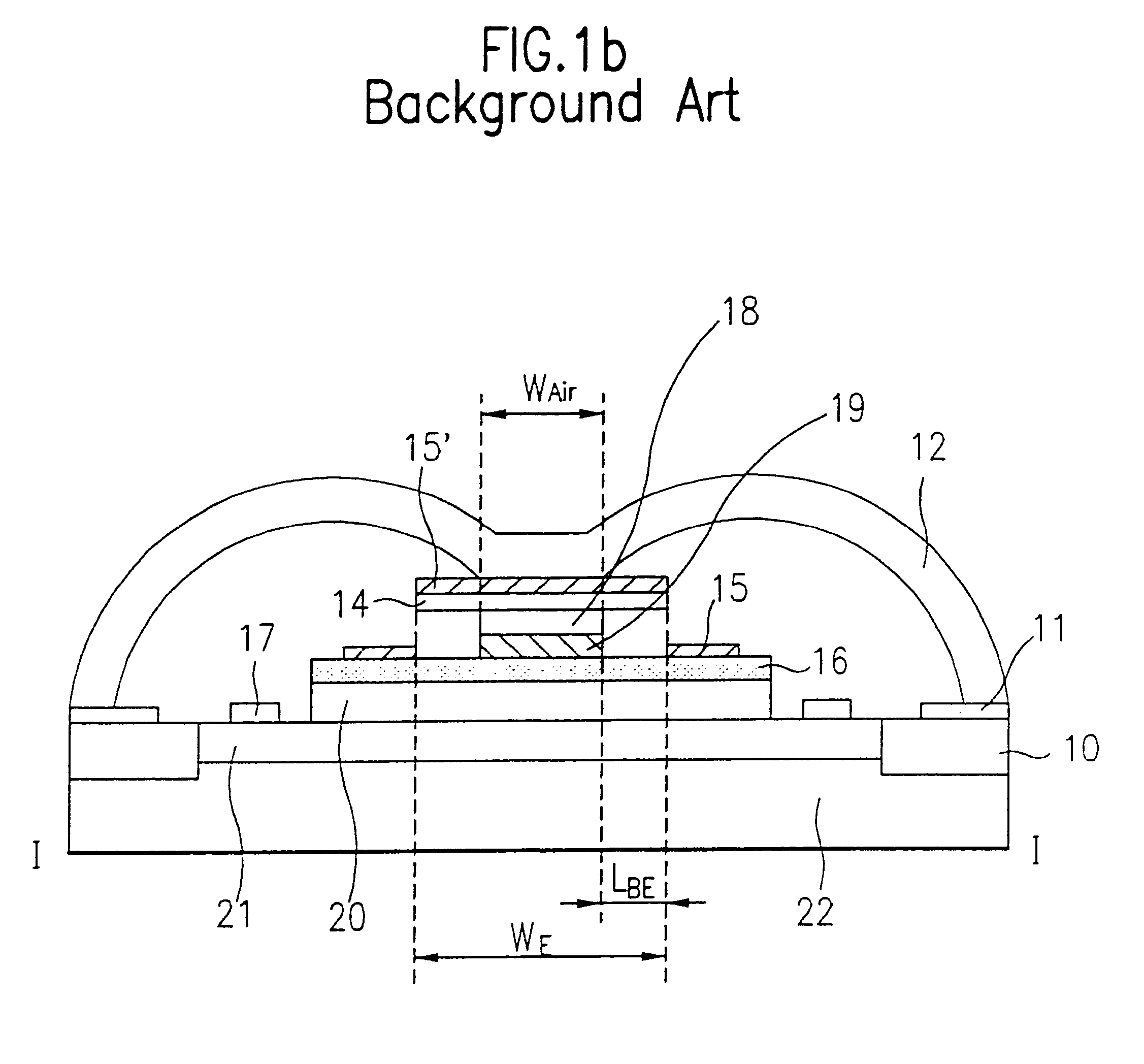Heterojunction bipolar transistor and its fabrication method
a bipolar transistor and heterojunction technology, applied in the field of bipolar transistors, can solve the problems of difficult control of the fabrication process of this structure, difficulty in raising the maximum usable oscillation frequency, and difficulty in achieving the effect of hbts in the related ar
- Summary
- Abstract
- Description
- Claims
- Application Information
AI Technical Summary
Problems solved by technology
Method used
Image
Examples
first embodiment
FIG. 5a is a plane view of an HBT according to the present invention, and FIG. 5b is a cross-sectional view of the HBT taken along the line II--II. A substrate 190 is composed of a normal semi-insulating semiconductor substrate and a sub-collector layer 250 is formed on the substrate 190. An insulating layer 100 is formed by implanting ions into the substrate as deep as a predetermined depth with respect to the sub-collector layer. A collector electrode 150 is formed in a defined profile on a portion of the sub-collector layer 250. A base layer 230 is deposited on a collector layer 240. An emitter layer 210 is formed in a defined profile on a part of the base layer 230, while an ohmic cap layer 200 is formed in the same profile as the emitter layer 210 on the emitter layer.
In the present invention, a base electrode 140 is formed in a defined profile at a position separated by a predetermined distance from the edge of the emitter layer on the base layer. An emitter electrode 130 cove...
second embodiment
FIGS. 8a-8e are cross-sectional views illustrating a fabrication process for the HBT according to the present invention. Referring to FIG. 8a, the procedures as described above in reference to FIGS. 6a-6h are repeated in the fabrication of the HBT shown in FIGS. 7a and 7b. The second insulating layer 220 and the emitter electrode 130 are used as a mask in etching the base layer 230 and the collector layer 240 to expose the sub-collector layer 250, as shown in FIG. 8b.
As shown in FIG. 8b, the electrode metal 110' is formed on the second insulating layer 220 to surround the base metal layer 140' on the emitter electrode 130. The second insulating layer 220 and the electrode metal 110' are used as an etching mask to define a base-collector PN junction. As shown in FIG. 8c, the electrode metal 110' is used as a mask in a second etching step for etching the second insulating layer 220. The etching technique utilized is a reactive ion etching using an oxygen plasma.
Subsequently, the colle...
third embodiment
the HBT has the a same structure as the first embodiment of the HBT with the exception of a first insulating layer sidewall 300' surrounding the ohmic cap layer and the emitter layer, and a depleted emitter layer 210' located under the first insulating layer. The fabrication procedures of FIG. 11i-11l are also analogous to those of FIGS. 6f-6j of the first embodiment.
Particularly, the depleted emitter layer 210' is formed in a defined profile on a portion of the base layer 230. The first insulating layer 300' surrounds the emitter layer 210 and the ohmic cap layer 200 with a height as high as the emitter layer 210 on the depleted emitter layer 210', while the second insulating layer is formed higher than the top surface of the ohmic cap layer 200 on the base layer 230 and the base electrode 140. "L" shown in FIG. 11f indicates the width of the depleted emitter layer 210' extending outside the boundary of emitter layer 210. The ledge (emitter surrounding band structure) protects the ...
PUM
 Login to View More
Login to View More Abstract
Description
Claims
Application Information
 Login to View More
Login to View More - R&D
- Intellectual Property
- Life Sciences
- Materials
- Tech Scout
- Unparalleled Data Quality
- Higher Quality Content
- 60% Fewer Hallucinations
Browse by: Latest US Patents, China's latest patents, Technical Efficacy Thesaurus, Application Domain, Technology Topic, Popular Technical Reports.
© 2025 PatSnap. All rights reserved.Legal|Privacy policy|Modern Slavery Act Transparency Statement|Sitemap|About US| Contact US: help@patsnap.com



